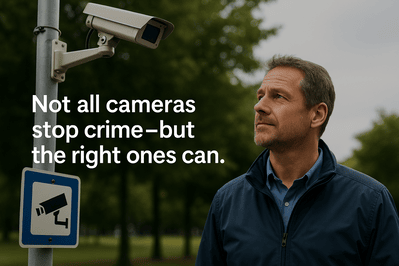
When it comes to municipal security, cameras shouldn’t just watch—they should work.
Too often, cities install surveillance systems that silently record footage no one ever sees. But smart municipalities understand: the right surveillance setup doesn’t just collect video—it actively discourages bad behavior.
Whether it’s vandalism in a public park, unauthorized dumping near public works, or after-hours loitering around city buildings, a visible, well-placed surveillance system can prevent incidents before they happen.
In this article, we’ll explore how to design surveillance for crime deterrence—not just observation—so your city can proactively protect its people, property, and budget.
k
k
Why Visibility Matters in Public Building Surveillance
Cameras are only effective deterrents when people know they’re there.
When a system is tucked away in an obscure corner or lacks visible signage, it may capture footage—but it doesn't send the psychological signal that deters unwanted behavior.
Research has consistently shown that the presence of visible cameras, especially with proper signage, reduces the likelihood of crime in public spaces. The key is intentional placement and messaging.
k
k
5 Strategies for Surveillance That Deters, Not Just Detects
1. Place Cameras Where They Can Be Seen—On Purpose
Don’t just cover a space—make sure people see they’re being watched. This includes:
-
Entryways to city buildings
-
Parking lot entrances
-
Park pavilions or high-traffic public zones
-
Areas with previous incidents (e.g., graffiti-prone walls, dumpsters)
Visible camera housings, even when combined with hidden coverage, change behavior. People tend to act more appropriately when they know surveillance is active.
l
l
2. Use Signage to Communicate Surveillance Clearly
Post signs that let the public know the area is under video monitoring. Effective signage:
-
Uses simple, clear language
-
References 24/7 recording or city monitoring
-
Includes the municipal logo or seal (adds authority)
-
Is placed at eye level near entrances, parking areas, and gathering spaces
This transparency builds trust with residents while discouraging bad actors.
l
l
3. Illuminate High-Risk Areas
Lighting and surveillance go hand in hand. A camera can’t deter what it can’t see.
Install motion-activated or dusk-to-dawn lighting in areas such as:
-
Rear entrances to public buildings
-
Remote sections of public parks
-
Fleet vehicle storage yards
-
Utility areas and water treatment plants
SSP often integrates lighting triggers into surveillance alerts, allowing for better visibility during off-hours and improving the quality of recorded footage.
l
l
4. Make Surveillance Part of Public Design
Instead of hiding security behind infrastructure, cities can incorporate surveillance into:
-
Decorative pole cameras in walkable downtowns
-
Modern bollards with embedded surveillance
-
Kiosks or intercom systems at park entry points
-
Public art that doubles as security hardware mounts
Done right, surveillance becomes a subtle but effective feature of public safety—not an eyesore or afterthought.
l
l
5. Choose Systems with Real-Time Monitoring or Alerts
Recording is helpful after the fact—but deterrence improves when systems are active. Consider:
-
Systems with real-time alerts for loitering, motion, or line crossing
-
Live monitoring through a city dispatch or remote command center
-
Audio-enabled systems with two-way voice (especially in lobbies or parks)
These technologies don’t just observe—they let city staff or law enforcement engage or respond immediately.
l
l
Real-World Example: Deterring Vandalism at a Downtown Pavilion
A small city in Georgia had repeated vandalism at its downtown event pavilion. Lights were broken, walls were tagged, and trash was routinely scattered after hours.
SSP worked with the city to install:
-
Visible dome cameras with IR night vision
-
Bold signage around the pavilion perimeter
-
Motion-triggered lighting
-
A monitoring service that alerts police to after-hours presence
Since installation, no incidents have been reported in over 9 months.
l
l
Key Takeaways
-
Visibility is a powerful deterrent—make cameras and signage obvious.
-
Lighting supports both deterrence and better footage.
-
Design surveillance into your space, not around it.
-
Active systems respond better than passive ones.
-
Community trust improves when surveillance is transparent and purposeful.
l
l
Final Thoughts
Installing cameras isn’t enough. If your goal is to reduce vandalism, loitering, and unauthorized activity, your surveillance system needs to send a message.
SSP specializes in designing smart, compliant, and community-friendly surveillance systems that don’t just record crime—they help prevent it.
l
l
Let’s Build a Safer, Smarter City Together
See how SSP helps municipalities protect their people and infrastructure through strategic, proactive surveillance solutions.
Contact us for a site walkthrough or risk assessment.


